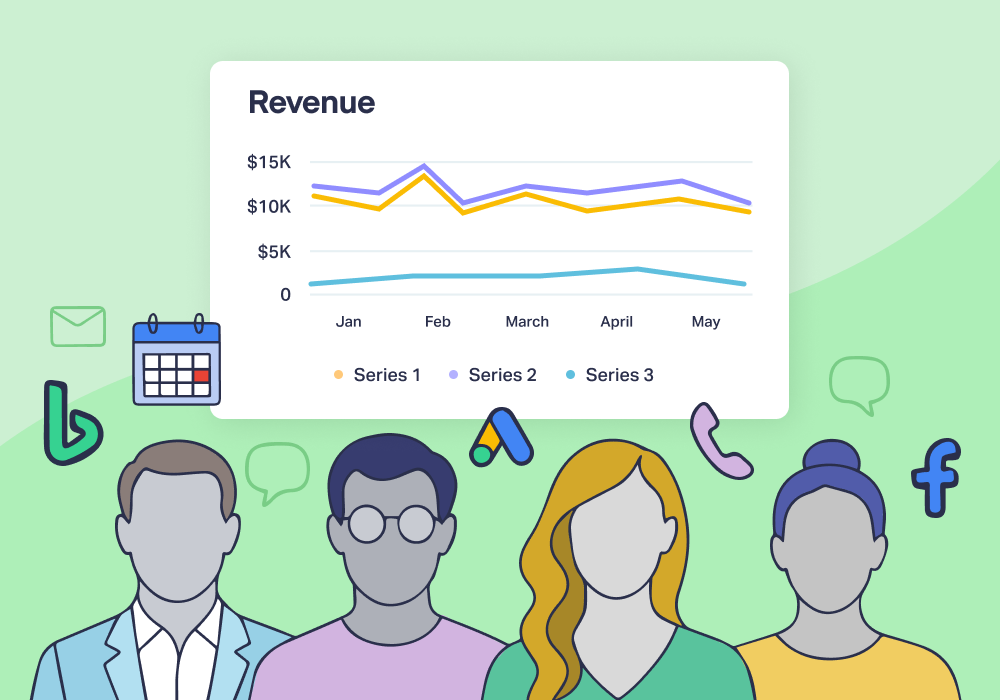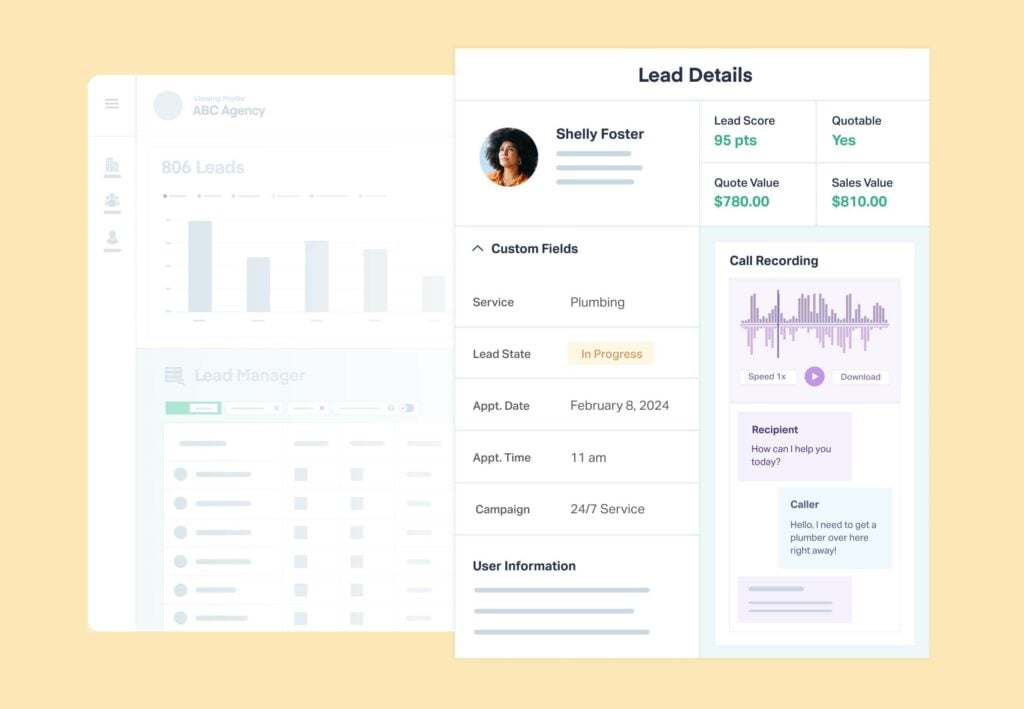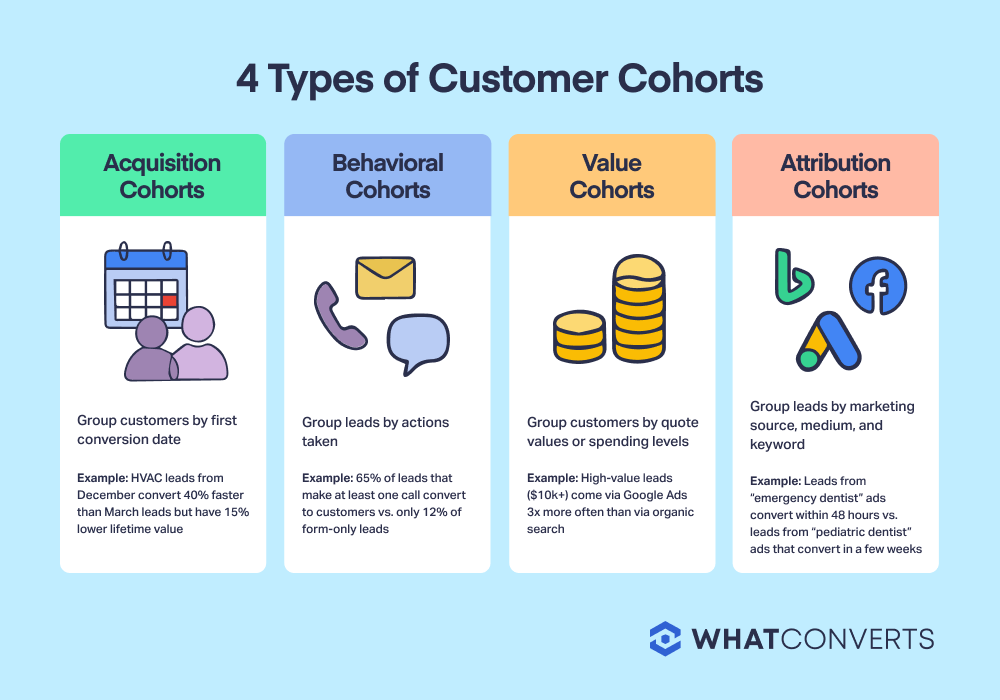
Your marketing dashboard shows impressive numbers:
- 1,000 leads generated last quarter
- 15% conversion rate
- $500,000 in total revenue
But when you try to figure out what's working so you can do more of it, you hit a wall.
That "15% conversion rate" includes leads from six months ago that only just signed contracts alongside leads from last week that have already closed. Your average revenue per lead is $500, but that includes $250 customers and your $2,500 customers, making it a useless metric for allocating your ad budget.
You’re comparing apples to oranges across time periods, mixing customers at different lifecycle stages, and treating all acquisition sources as equal. Your metrics tell you what happened overall, but not when, why, or which types of customers are actually driving results.
Customer cohort analysis solves this problem by grouping customers that share specific characteristics and tracking how each group performs over time.
Read More: Agency Segments Leads by Type, Grows Volume 220% [Case Study]
Beyond Averages: The Power of Cohort Thinking
Aggregate metrics are the marketing equivalent of fool's gold—they look valuable on the surface but hide the real treasure underneath. When you see "average customer lifetime value: $2,500," you're missing the story of how your $10,000 customers differ from your $500 customers, where they come from, and what early signals predict their value.
Cohort analysis reveals what efforts led to which results. Instead of wondering why your overall conversion rate dropped last month, you can see that leads from paid social campaigns converted 30% worse while organic search leads maintained their performance. This specificity transforms guesswork into actionable insights.
The key difference between segments and cohorts lies in the time dimension:
- Segments are static groupings—"all customers who spent $1,000+"
- Cohorts are dynamic groups tracked over time—"customers who joined in January and spent $1,000+ in their first six months"
This timeline element reveals patterns that static analysis misses.
4 Essential Data Points for Cohort Analysis
Building a cohort mindset in your marketing team starts with collecting individual lead data rather than anonymous conversions. While traditional analytics might tell you that 500 people filled out forms, cohort analysis requires you to know who those 500 people are, when they converted, and how they behave over time.
This is where the importance of individual lead data becomes clear—platforms like WhatConverts capture 70+ data points per lead, providing the granular information needed for sophisticated cohort analysis. While all of these data points are useful, there are four key pieces of information required for a comprehensive cohort assessment:
- Precise Timing Data: Capture exactly when each lead is converted, down to the date and time. This becomes the foundation for creating acquisition cohorts.
- Individual Lead Identity: You need to know who each lead is, not just that a conversion happened. This means capturing contact information like name, email, and phone number.
- Complete Attribution Information: Track the full marketing source path: which campaign, keyword, ad, and landing page brought each lead to you.
- Behavioral Data: Record what actions each lead takes: did they call, fill out a form, start a chat, or complete multiple actions?
Using WhatConverts to Automatically Capture Cohort Data
WhatConverts solves the data collection challenge with a single tracking script that captures all necessary information:
Within the Lead Manager, each converted lead’s information is stored in individual lead profiles that include:
- Complete contact information
- Exact conversion timestamp
- Full marketing attribution (source, medium, campaign, keyword)
- Conversion type (call, form, chat)
- Lead scoring and qualification status
The detailed lead view shows the complete customer journey, including:
- First-touch attribution
- All subsequent marketing interactions
- Timeline of engagement activities
- Quote values and sales outcomes
This comprehensive data collection happens automatically once you install the WhatConverts tracking script, eliminating manual data entry and ensuring consistent, accurate information for cohort analysis.
Customer Cohort Types and Applications
Understanding the four main types of customer cohorts helps you choose the right approach for your marketing challenges:
Acquisition Cohorts: When They Joined
Acquisition cohorts group customers by when they first converted, revealing how different time periods perform over their lifetime. For example. December leads might convert 40% faster than March leads but have 15% lower lifetime value.
Using lead capture dates and first-touch attribution data from your tracking system, you can create acquisition cohorts that show seasonal patterns, campaign performance over time, and the long-term impact of market conditions on customer quality.
Behavioral Cohorts: How They Engage
Behavioral cohorts segment leads based on specific actions they take to understand how engagement patterns predict long-term value. For example, you might find that leads who called first close at 65% vs. form-only leads who close at 12%.
By leveraging call recordings, form submissions, and chat transcripts, you can identify which early behaviors signal high-value prospects. This analysis helps you optimize not just for lead volume, but for lead quality based on engagement patterns.
Value Cohorts: What They Spend
Value cohorts organize customers by spending levels or quote values to identify your highest-ROI acquisition channels. For example, high-value leads ($10K+) might come 3x more often from LinkedIn than Facebook ads.
Using quote values and sales values tracked in your system, you can create value-based cohorts that reveal which marketing channels consistently deliver premium customers, allowing you to shift budget toward your most profitable sources.
Channel Cohorts: Where They Came From
Channel cohorts compare how leads from different marketing sources behave and convert over time to optimize budget allocation. For example, you might learn that Google Ads leads have 2x higher 6-month retention than organic search leads.
Read More: Pinpoint Your Best Channels with the Leads by Source Report
With precise attribution across calls, forms, chats, and e-commerce, you can accurately assess channel performance beyond initial conversion rates. This long-term view often reveals that seemingly expensive channels deliver superior customer lifetime value.
Turning Data into Cohort Insights
With proper data collection in place, you can start creating and analyzing cohorts to drive better marketing decisions.
Create Your First Cohorts
Using the data captured in WhatConverts, set up cohorts based on your business objectives:
- For Budget Optimization: Create channel cohorts to compare Google Ads vs. Facebook vs. organic search performance over time.
- For Campaign Timing: Build acquisition cohorts by month or quarter to identify seasonal patterns in lead quality.
- For Lead Scoring: Develop behavioral cohorts based on first actions (called vs. filled form) to predict conversion likelihood.
Analyze Performance Over Time
Track how each cohort performs throughout their lifecycle:
- 30-day conversion rates by acquisition source
- Average deal size by behavioral patterns
- Customer retention by original campaign
- Lifetime value trends across different time periods
Use WhatConverts' custom reporting to create dashboards that automatically update as cohorts mature, giving you ongoing visibility into long-term performance patterns.
Optimize Based on Cohort Insights
Apply cohort findings to improve marketing performance:
- Reallocate budget toward channels that produce high-value, long-term customers
- Adjust campaign timing based on seasonal cohort performance patterns
- Refine targeting using behavioral signals that predict successful cohorts
- Improve lead nurturing by understanding typical cohort lifecycle stages
Acquisition Insights: Discovering Your Best Lead Sources
One of the most powerful applications of cohort analysis is comparing how different acquisition channels perform over the long term. Surface-level metrics often mislead—the channel with the lowest cost-per-lead might actually deliver your least valuable customers.
Beyond Initial Conversion Rates
Consider this scenario: Facebook ads generate leads at $50 each while Google Ads cost $75 per lead. Traditional analysis favors Facebook, but cohort analysis reveals:
90-day performance:
- Facebook cohort: 15% conversion rate, $1,200 average deal size
- Google Ads cohort: 25% conversion rate, $2,800 average deal size
Result: Google Ads delivers 85% higher revenue per lead despite the higher acquisition cost.
Identifying Channel Quality Patterns
Track these key metrics by acquisition cohort:
- Time to conversion (which channels produce quick closers vs. long nurture cycles)
- Deal size distribution (which sources attract premium vs. budget customers)
- Retention rates (which channels deliver sticky, long-term customers)
- Referral generation (which customers become advocates)
Use these insights to make informed decisions about where to invest your marketing budget for maximum long-term return.
Getting Started with Cohort Analysis
Customer cohort analysis transforms marketing from guesswork into data-driven strategy. By tracking how different groups of customers behave over time, you uncover patterns that aggregate metrics cannot reveal.
The key to success lies in having proper individual lead tracking as your foundation. When you can see who your leads are, where they come from, and how they behave over time, you unlock insights that drive real business growth.
Ready to discover the hidden patterns in your marketing data? WhatConverts provides the lead tracking foundation that makes cohort analysis possible—start your free trial today.
Get a FREE presentation of WhatConverts
One of our marketing experts will give you a full presentation of how WhatConverts can help you grow your business.
Schedule a Demo
Grow your business with WhatConverts







